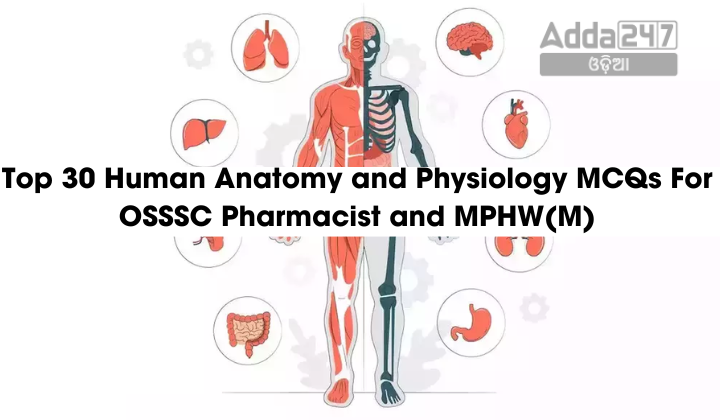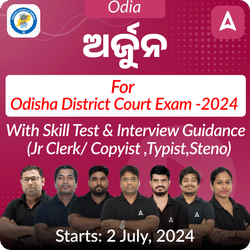Preparing for the OSSSC Pharmacist and MPHW(M) exams requires a solid understanding of human anatomy and physiology. To help you get started, we’ve compiled a list of the top 30 multiple-choice questions (MCQs) that cover key concepts in these subjects. Let’s dive in!
Top 30 Human Anatomy and Physiology MCQs For OSSSC Pharmacist and MPHW(M)
- What is the basic unit of life in the human body?
A) Atom
B) Molecule
C) Cell
D) Tissue
Answer: C) Cell - Approximately how many cells does an average adult human body contain?
A) 10-20 trillion
B) 30-40 trillion
C) 50-60 trillion
D) 70-80 trillion
Answer: B) 30-40 trillion - Which process involves the formation of new cells every day?
A) Metabolism
B) Mitosis
C) Meiosis
D) Apoptosis
Answer: B) Mitosis - What do cells combine to form?
A) Organs
B) Organ systems
C) Tissues
D) Organisms
Answer: C) Tissues - What is the primary function of the skeleton?
A) Transport nutrients
B) Protect vital organs
C) Produce energy
D) Digest food
Answer: B) Protect vital organs - How many bones does an adult human have?
A) 206
B) 208
C) 210
D) 212
Answer: A) 206 - What type of tissue connects bones to other bones?
A) Tendons
B) Cartilage
C) Ligaments
D) Muscle
Answer: C) Ligaments - Which of the following is NOT a type of joint movement?
A) Rotation
B) Abduction
C) Flexion
D) Extension
Answer: D) Extension - How are muscles attached to bones?
A) Ligaments
B) Cartilage
C) Tendons
D) Joints
Answer: C) Tendons - What happens when a muscle contracts?
A) It lengthens and relaxes
B) It shortens and stiffens
C) It breaks down
D) It becomes immobile
Answer: B) It shortens and stiffens - Which organ system is responsible for transporting nutrients and waste products?
A) Digestive system
B) Respiratory system
C) Nervous system
D) Circulatory system
Answer: D) Circulatory system - What is the primary function of the digestive system?
A) Transport blood
B) Break down food and absorb nutrients
C) Protect internal organs
D) Support body movement
Answer: B) Break down food and absorb nutrients - Which of the following is NOT part of the digestive system?
A) Stomach
B) Liver
C) Heart
D) Small intestine
Answer: C) Heart - What organ produces bile to aid in digestion?
A) Stomach
B) Liver
C) Pancreas
D) Small intestine
Answer: B) Liver - What is the role of the kidneys in the human body?
A) Store bile
B) Filter blood and produce urine
C) Produce digestive enzymes
D) Transport oxygen
Answer: B) Filter blood and produce urine - What is the primary function of the respiratory system?
A) Circulate blood
B) Digest food
C) Exchange gases (oxygen and carbon dioxide)
D) Protect internal organs
Answer: C) Exchange gases (oxygen and carbon dioxide) - Which structure in the lungs is responsible for gas exchange?
A) Bronchi
B) Trachea
C) Alveoli
D) Diaphragm
Answer: C) Alveoli - What is the main function of the nervous system?
A) Digest food
B) Circulate blood
C) Coordinate body activities
D) Exchange gases
Answer: C) Coordinate body activities - Which part of the brain controls thinking and voluntary movements?
A) Cerebellum
B) Brainstem
C) Cerebrum
D) Hypothalamus
Answer: C) Cerebrum - What does the spinal cord connect?
A) Brain and digestive system
B) Brain and peripheral nerves
C) Heart and lungs
D) Liver and pancreas
Answer: B) Brain and peripheral nerves - What is the function of the peripheral nervous system?
A) Control voluntary actions only
B) Control involuntary actions only
C) Connect the central nervous system to limbs and organs
D) Protect the brain
Answer: C) Connect the central nervous system to limbs and organs - Which of the following is a part of the female reproductive system?
A) Testes
B) Uterus
C) Prostate gland
D) Vas deferens
Answer: B) Uterus - Which hormone is produced by the ovaries?
A) Testosterone
B) Insulin
C) Estrogen
D) Adrenaline
Answer: C) Estrogen - What is the primary function of the male reproductive system?
A) Produce eggs
B) Produce sperm
C) Secrete digestive enzymes
D) Exchange gases
Answer: B) Produce sperm - What is the main organ of the male reproductive system?
A) Ovaries
B) Uterus
C) Testes
D) Vagina
Answer: C) Testes - What type of circulation involves the lungs?
A) Systemic circulation
B) Pulmonary circulation
C) Coronary circulation
D) Portal circulation
Answer: B) Pulmonary circulation - What component of blood is responsible for transporting oxygen?
A) White blood cells
B) Plasma
C) Platelets
D) Red blood cells
Answer: D) Red blood cells - What part of the brain regulates vital functions like heartbeat and breathing?
A) Cerebrum
B) Cerebellum
C) Brainstem
D) Hippocampus
Answer: C) Brainstem - What is the function of the cerebellum?
A) Control thinking and memory
B) Regulate hormones
C) Coordinate movement and balance
D) Process sensory information
Answer: C) Coordinate movement and balance - Which system includes the skin, hair, and nails?
A) Circulatory system
B) Respiratory system
C) Integumentary system
D) Digestive system
Answer: C) Integumentary system










